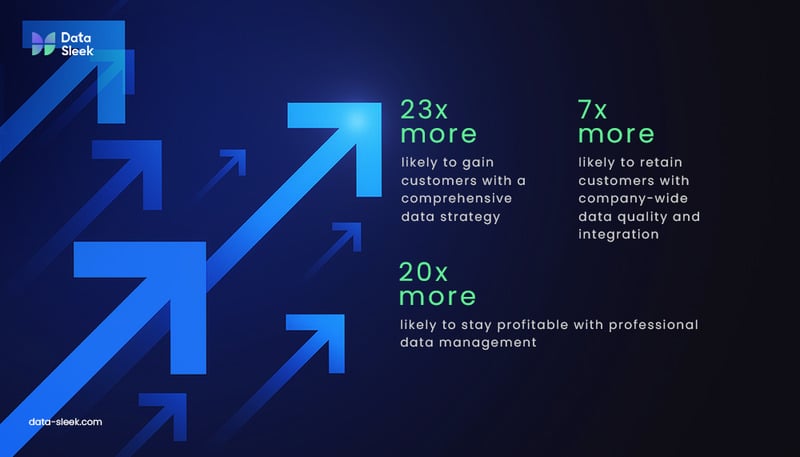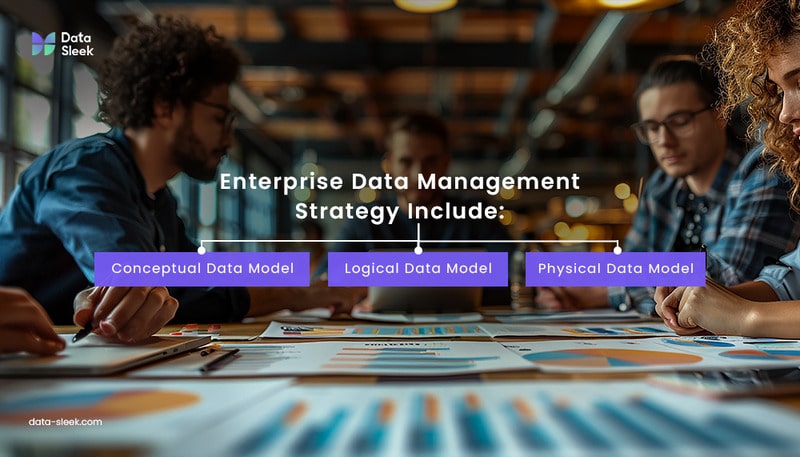The Enterprise Data Management Strategy Guide You Need to Supercharge Growth
Unleashing Your Superpower
We all know the maxim “he who has the gold, makes the rules.” In today’s tech-driven economy, the gold of bygone days has been replaced with data. Directing, manipulating, and harnessing your data puts untold power at your fingertips, and allows you to control your most valuable asset, and your modern-day gold.
Diagnosing a data problem doesn’t have to be complicated. Enterprise data management ensures that all the data your business collects is properly stored, organized, and structured into a seamless system. This allows for easy retrieval, analysis, and dissemination—helping you craft a data-driven strategy aligned with your business objectives. Additionally, it safeguards proprietary information, ensuring compliance with industry regulations. If you’re looking to optimize your data processes, explore our Data Management Consulting Services to unlock the full potential of your enterprise data.
Using An Enterprise Data Management Strategy to Navigate A Complex Roadmap
Think about your data as countless roads on a map: without a navigation system, all you see is a maze on paper. Identifying and documenting data sources is crucial to ensure the integrity and transparency of your data management strategy.
Now imagine using an Enterprise Data Management Strategy as a high-powered GPS system. All of a sudden, you’ve transformed unintelligible information into a meaningful, powerful tool. EDM is your company’s roadmap to scalable growth and visibility, guiding you through every twist and turn as you elevate.

Charge Up Your Growth
It isn’t just a rumor that companies that prioritize their data management strategies maximize their year-over-year revenue growth, onboard more high-caliber people, and occupy a greater market share than those that don’t. Aligning data management efforts with business objectives ensures the success of enterprise data management (EDM) programs.
Businesses that use a comprehensive data strategy are 23 times more likely to gain more customers than their competitors. Furthermore, those businesses that ensure data quality and data integration company-wide are seven times more likely to retain those same customers. Effective data management serves as more than just a one-shot competitive advantage. Entrusting your data stewardship to data professionals ensures that a business is nearly 20 times more likely to remain profitable over time.

Using Data Enterprise Management as a Strategic Tool
Customer adoption, engagement, and retention metrics can be skewed when your existing data strategies aren’t built for speed, or size. Aligning data management efforts with business objectives is crucial to ensure the success of your enterprise data management programs.
It’s an all-too-familiar story: strategic marketing campaigns are fine-tuned and customer participation grows. Your consumer data coming in a steady stream now feels like you’re drinking from a fire hose, and your current data management strategy is overloaded.
Don’t let your data management efforts drown you. Being flooded with data is perhaps the best sign that your business is designed to flourish with the help of the right data integration tools. Investing in robust enterprise data management tools that are tailor-made for your company’s needs can help you make sense of your data influx and enable your business to grow.
The temptation to stick with antiquated internal data integration tools is natural, but be wary: studies show that only 46% of executives were able to handle the data and provide value to their organizations. Rather than burdening your own infrastructure with a top-heavy data warehouse, outsourcing to data professionals with high-capacity, flexible data architecture in place. As you scale, there will be an increased need to slash time spent searching for data.
According to McKinsey, 19% of working hours are spent searching for information. For businesses in the start-up phase with a less robust data governance committee, that number may be much higher. Let’s take a closer look at how implementing an enterprise data management strategy works to solve this issue.
Cleaning House: Decluttering Your Space and Organizing Your Assets
Implementing an effective enterprise data management strategy involves several key components that come together to form a robust infrastructure. The general process for building any data management strategy follows the same trajectory:
- Data Management: This includes all disciplines related to managing data as a valuable resource. It’s the spine that connects all segments of the information lifecycle.
- Data Integration: This involves combining data from multiple sources into a unified view.
- Data Transformation: Once data is integrated, it undergoes process to be cleaned, standardized, and structured to fit the desired format for analysis.
- Data Warehousing: This is where transformed data is stored in a centralized repository for analysis and reporting.
- Data Visualization: The final step involves presenting data in a visualized format, such as charts and graphs, and used for strategic decision-making.

A Place for Everything, and Everything in its Place
Like a library uses the Dewey decimal system to organize books by author and category, a data warehouse stores and categorizes data into easy-to-find locations. Data warehouses are the backbone of a master data management system. Categorizing and sorting data into proper containers assures better data quality and turns it from a liability into a strategic asset. Storing your data coherently lets you observe trends over time and see patterns, helping you create better business strategy.
A data mart makes your data more granular. It encapsulates data in smaller, more specialized parts of the warehouse. It organizes data by subject or function, expediting its acquisition for business units. Data marts create a world in which the accounting department can easily find its data, because it is stored in a different data mart than, say, marketing. Timely data amplifies your operational efficiency and more powerful business intelligence.
Transforming Data to Extract the Golden Nuggets
With all of that valuable data elegantly stored, it’s time to make it work for your business. Enterprise data management strategies use business analytics to transform the noise into a clear signal: The job of data professionals is to transform the heap of incoming information into insights into:
- Customer behavior and purchasing patterns
- Trends in the marketplace
- Fluctuations in sales
Applying business analytics paves the way to data-driven decision making. Putting this newfound business intelligence at your fingertips gives clarity into decision making and enhances strategic planning.
Insights from business analytics allow your company to develop evidence-based solutions to complex problems and even predict future outcomes.
Business analytics provide answers your company needs to simplify and streamline your operating procedures: What products are selling the best? Why did sales drop last month? Which marketing campaigns are driving the most traffic? Clarifying the best business practices gives you the strongest outcomes.
Giving you the most useful business intelligence is at the core of an enterprise data management strategy. In essence, the result of business analytics is taking sales numbers, customer feedback, and website traffic and finding patterns, trends, and insights that aren’t immediately apparent.
Raw Data into Valuable Information
With all of that valuable data elegantly stored, it’s time to put it to work for your organization. Data mining is a figurative sieve in the sandbox, sifting through billions of pieces of your company’s data to solve problems, predict trends, mitigate risks, and find new opportunities. Finding valuable insights can help leverage your business intelligence. Spotting trends in retail sales, for example, might let you pinpoint which customers are most likely to buy particular products.
After your data has gone through the centrifuge, let an enterprise data strategy take your growth potential one step further. Predictive analysis puts the control in your hands by letting you exploit your data to maximize its potential. Using predictive data analytics can forecast customer behavior, configure layouts of a brick-and-mortar retail or service location, and target marketing strategies toward certain customer demographics. Data driven decision making is the turbo-booster for your master data management strategy.

Maximize Your Processes and Establish Data Management Standards
Regulatory Compliance
Compliance with mercurial regulations is more important than ever. An enterprise data management system is crucial to keeping far ahead of punitive fines, legal headaches, and corrupted data. A company that uses a strong data management system is protected in the event of an audit with detailed records and documentation of their data management activities. Often, regulations include requirements for data security, like encryption and access controls. Having an EDM in place minimizes the risk of data exposure, and the risk of not meeting security requirements.
Effective data management ensures that your information is high-quality and easy to access for internal applications. Accessibility and data quality helps facilitate decision making so you can achieve targeted business outcomes.
- A 2023 survey conducted by the International Data Corporation shows that businesses that establish strong data governance and standards see a 20-40% improvement in operational efficiency.
- Poor data quality is responsible for business losses of up to $3.1 trillion per year in the United States alone. The majority of these losses come from the lack of standardized data processes leading to unresolved errors, inconsistencies, and inefficiencies.
- Over half of businesses struggle to meet compliance regulations, leading to costly fines and damage to their reputations. In fact, Gartner reports that a staggering 65% of businesses with insufficient data governance structures have trouble meeting regulatory requirements and ensuring data security. Strong data governance builds trust and customer loyalty.
Operational Efficiency and Sustainable Stewardship
Time and again, enterprise data management systems prove to be an invaluable resource in amplifying the operating efficiency of your company. A key component in this is centralizing all your company’s data, making it easily accessible to everyone who needs it. This eliminates the time wasted searching for information across multiple systems or spreadsheets, allowing employees to focus on more value-added tasks.
- Designated Accountability: Did you know that companies that have dedicated data stewards increase their operational efficiency by more than a 2-fold margin? Built-in accountability frameworks provide resources to make data-driven decisions and identify key data points in terms of customer insights
- Break down barriers: Data silos, or isolated chunks of information overseen by only one department, slow down collaboration and impede transparency. Businesses with high operational efficiency and data stewardship decrease these silos by up to 50%, improving synergistic cooperation and improving the quality of data driven decision making.
- Risk Mitigation: About two-thirds of companies already understand the direct link between strong data stewardship and risk mitigation associated with data breaches and cyberattacks. You worked hard to amass your company’s data. Leaving it vulnerable to hacking is preventable when you employ the right data solutions.
Breaking Walls to Wellness: When Health Karma, a subscription-based telehealth platform, realized their ability to provide the best service to patients, they reached out to Data-Sleek. Health Karma uses an innovative suite of services to unify the patient wellness journey onto one intuitive platform, eliminating the need for separate portals to input insurance data, medical history, and prescription information. Their challenge? Fragmented data and an overloaded data management system. Data-Sleek constructed a data pipeline and data warehouse to consolidate, organize, and analyze their data. Health Karma’s investment paid off in spades, improving their retention rates, increasing conversion rates by 25%, and garnering even more subscribers, while seamlessly integrating new data.
Building Up From a Strong Foundation
Just like homeowners work with their builder to design and construct their perfect home, business leaders partner with data leaders to create the right structure, or data architecture, for their information. Identifying and documenting various data sources is crucial in building a strong data architecture. Data architecture is fundamental to an organization’s ability to manage, analyze, and utilize data: it is the bedrock of the data strategy.
Organizations that use a solidly built data architecture can slash their data management costs by up to 30%, as opposed to using internal infrastructure. The right enterprise data management strategy helps to:
- Break down data silos by eliminating interdepartmental barriers
- Excise redundant data, making your results easier to read and interpret
- Eliminate fragmentation by cleansing debris and leaving you with accurate and timely data
- Launch new products faster, giving your company the upper hand in the marketplace
Remember: Low-quality data equals high costs.

Designing Enterprise Data Management Solutions for Your Business
Your data management architecture consists of a broad framework, or data model, that defines how your data is categorized and used within your organization. Your enterprise data management strategy will include:
Conceptual Data Model: The broadest model level, this is an abstract representation of an company’s data management needs and how different aspects within the business relate to each other
Logical Data Model: Fleshes out in some detail just how your data management system will look, including specific data categories and their traits, but is not bound by any specific, physical implementation
Physical Data Model: The most refined perspective, this model shows a top-down view of how the data will be stored and accessed in the database

When Enterprise Data Solutions are Right for Your Organization
Depending on the existing infrastructure of your organization, implementing an enterprise data management solution can be quite a complex process. However, a little effort goes a long way. Whether your current data management practices are in need of a total rebuild or just a fine-tuning, consider some of the proven benefits of taking that first step:
Operate More Efficiently
Eliminating data silos and redundancy gives you better operational efficiency and the ability to allocate resources more productively, resulting in higher revenue.
Improved Decision Making
Enterprise data management makes sure that your company’s data is accessible, error-free, free from redundancies. High-quality data gives an organization’s leaders a clearer picture of opportunities for growth. decision-making, leaders can trust the information they use to strategize and identify opportunities for growth.
Forecast Customer Insights
Predictive data analysis models are the cornerstone of deeper insights into customer behavior, preferences, and purchasing trends. Target your marketing to create personalized customer experiences, and see an uptick in customer satisfaction and loyalty.
Comply with Government Regulations
Falling short of complying with capricious data regulations such as GDPR, HIPAA, or CCPA is a surefire way to cost you money, not to mention reputational damage. Steer clear of punitive fines and bolster trust with customers and business partners alike while maintaining data security.
Stop Damage Before It Starts
Security tools used by an enterprise data management system, such as encryption, disaster recovery, advanced analytics and monitoring user activity mitigate risks to your security. An ounce of prevention can save the financial health and reputation of your organization.
Not Sure Where to Start? Consider Hiring an Enterprise Data Management Professional
Becoming stronger, faster, powerful, and more efficient doesn’t happen by accident. Enterprise data management systems streamline data access, improve accuracy, and automate processes so you’ll not only boost productivity but also drive revenue growth like never before. When you are unambiguous in your destination, let the empirically-proven power of data intelligence help drive you there.
More data means greater potential, but only if that data is meaningful. Remarkably, only 24% of employees feel confident in their ability to read, analyze, and interpret data effectively. Enterprise data management will help close the gap in data literacy to give your business the room you want to grow.
Deciphering the data landscape often feels intimidating and complex. You don’t have to go it alone. From trusted financial leaders and asset management firms to health and wellness innovators, the fastest-growing businesses today turn to enterprise data management to land at their desired outcomes. Schedule your free consultation with Data-Sleek today to join the ranks of continuous improvement and competitive growth.



